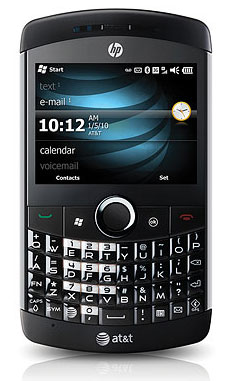|
HP iPAQ Glisten
The iPAQ lives on as a smartphone
(by Conrad H. Blickenstorfer)
Back in 2000, the Compaq iPAQ rang in the modern era of Pocket PCs and probably singlehandhedly saved Microsoft's fledgling Pocket PC platform.  Since then, Pocket PCs have pretty much given way to smartphones, and so on November 24, 2009, HP annunced the HP iPAQ Glisten, a new Windows Mobile-powered smartphone for the AT&T network. Since then, Pocket PCs have pretty much given way to smartphones, and so on November 24, 2009, HP annunced the HP iPAQ Glisten, a new Windows Mobile-powered smartphone for the AT&T network.
Apart from running the latest version of Microsoft's everchanging Windows CE/Windows Mobile platform, the oddly named iPAQ Glisten's most distinguishing feature is its AMOLED (active-matrix organic light-emitting diode) screen. AMOLED displays are very bright and don't need a backlight because the pixels themselves illuminate. AMOLEDs also are said to offer better image quality and use less power than conventional LCDs.
Other than that, the iPAQ Glisten is a more or less standard smartphone. It uses a 528MHz Qualcom MSM 7200A processor to run Windows Mobile 6.5 Professional. Those who haven't looked at Windows Mobile in a while will find a completely new graphical user interface, though things underneath haven't changed much. There's 256MB of RAM and 512MB ROM, and the Glisten has a microSDHC slot that can accommodate cards up to 32GB. There's also a 3.2 megapixel fixed-focus camera with 5X digital zoom.
As far as phone functionality gos, the Glisten is a quad-band 3G world-phone. In the US it supports 850/1900MHz GSM/GPRS/EDGE and UMTS/HSDPA. It also includes 802.11b/g WiFi, GPS and, optionally, Bluetooth.
On the software side, you get the mobile versions of Microsoft Office, Outlook, Internet Explorer, Media Player, etc. GPS software is optional, and there's the usual wealth of utilities as well as MSN Money, MSN Weather, a Facebook app and more.
The iPAQ Glisten is operated via touch screen or via its somewhat busy 39-key QWERTY keyboard and a 5-way diretional pad. No word on battery life.
|





























